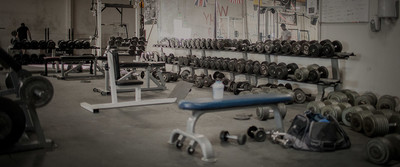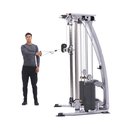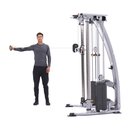The first place to get hurt and the last place to get big on most guys is the shoulder area. Too much pressing and too little preventative training often lead to long-term, painful shoulder injuries. And you can't train much of your upper body if your shoulder hurts.
With the "back-to-front" approach to building big shoulders, you can put size and definition on your delts while minimizing the pain common to most shoulder workouts.
The goals of this shoulder training program are to reduce injury risk, build cannonball delts, and balance your deltoids for size and definition (also known as achieving muscle symmetry - the bodybuilder's ultimate goal). Consider this new-era, Underground bodybuilding training.
Shoulder Training Rules
Now, to achieve the goal of big, healthy shoulders, you need to follow a couple of rules.
- Start each session by training the muscles at the back of the shoulder and then progress to training the muscles of the middle deltoid, and then finish the workout by training the front of the shoulder. You will also use these exercises as a warm-up to prepare the smaller muscles of the shoulder joint for the heavy overhead pressing.
- Limit the amount of overhead pressing to one main exercise per shoulder workout. And only do overhead pressing if you have healthy shoulders to begin with. In order to do this, you have to be creative and smart with your choices of lateral raise exercises to stimulate the muscles to grow.
- Take into consideration all of the other shoulder-stressing exercises you are doing in your training week and adjust the amount of overhead pressing you do in your shoulder workout. For example, if you are doing barbell and incline bench press, then you should limit your overhead pressing on shoulder day.
- On the other hand, with this program, since you are going to be doing some overhead pressing, we recommend that you eliminate all barbell bench pressing for the 4 week program. Use only dumbbells for your chest workout.
- Use a cable pulley system as much as possible to get maximum tension on the deltoids while working through a full range-of-motion (ROM) in all lateral raise exercises.
- Use a tempo for each repetition. If your program is not manipulating exercise tempo, then your bodybuilding workout is not as good as it can be. You don't use the same sets and reps do you (do you?), so why would you use the same speed for each repetition every workout?
What Does Tempo Mean?
Tempo refers to lifting speed. The first number is lowering, the second is pausing in the bottom position, and the third is lifting. So a 4-1-2 tempo would be a 4 second lowering, a 1 second pause, and a 2 second lift.
You always want to control the weight (although there are some exceptions to this rule for the advanced trainee - but that's another article). So the eccentric is no faster than a 2 second lowering, for safety and growth.
What's The Difference Between Eccentric And Concentric?
Eccentric movements are those exercise movements involving the lengthening of muscle fibers. They are the opposite of concentric movements, which involve the contracting of the muscles.
- Perform this shoulder workout as the last workout of the week and give yourself two full days of recovery before attempting another upper body workout. So if you train chest-pressing movements on Monday (and who doesn't?), then you should do this shoulder workout on Friday and then rest over the weekend.
- Only use this workout if your goal is to prioritize shoulder growth in your training cycle.
Shoulder Workout
Exercise descriptions: (See the bottom of this article.)
Warm-up: For a specific warm-up, perform 1 set of 8 reps for each exercise in each superset with 75% of the weight you will use in your first "real set."
Each pair of exercises constitutes a "Superset." In each Superset, do one set of the first exercise (A1) followed immediately by the next exercise (A2). Rest 1 minute and repeat.
What Are Supersets?
A superset is the alternating back and forth between two (or more) exercises until the prescribed number of sets is complete, usually with no rest between exercises. There are various types of supersets, however.
Find more definitions in our glossary.
Use the correct weight for each exercise that allows you to get all repetitions completed with perfect form and the recommended tempo. The strict tempo will require you to decrease the weights by at least 10% on most exercises compared to your regular sessions.
Perform all exercises according to the tempo prescribed.

BodyFit
$6.99/month- 2,500+ expert-created single workouts
- 3,500+ how-to exercise videos
- Detailed workout instruction
- Step-by-step workout tips
- Training at gym or at home
- Access to Workout Plans
- Access to Bodyfit App
- Store Discounts
Already have a Bodybuilding.com account with BodyFit? Sign In

What comes with BodyFit?

- Instructional Videos
Don't risk doing a workout improperly! Avoid injury and keep your form in check with in-depth instructional videos.

- How-to Images
View our enormous library of workout photos and see exactly how each exercise should be done before you give it a shot.

- Step-by-Step Instructions
Quickly read through our step-by-step directions to ensure you're doing each workout correctly the first time, every time.
bent-over low pulley side lateral
If possible, use a cable pulley system for this exercise. It can be done one arm at a time with a cable pulley system. Contract your glutes, brace your abs and keep your spine in a neutral position. Stand with your knees bent slightly and your upper body bent parallel to floor. Perform a lateral raise, lifting the cable up and out to the side.
Reverse flyes with external rotations
Set an adjustable bench to a 60-degree incline position. Grab a pair of light dumbbells (even lighter than what you would use for the rear-delt raise) and lie chest down on the incline bench. With your chest supported by the bench, raise the DB's up and out to your sides in a Y pattern. From overhead, it will look like your upper body is forming the letter Y.
As you raise the weights, your shoulder blades should come together. This exercise works less-often used muscle groups including the middle portion of your traps, your rhomboids (between your shoulder blades), and your rear-deltoids.
Standing Low-Pulley Deltoid Raises
Stand with your left side facing a low pulley with a single handle. Hold with your right hand. Stand straight up wth your head up. Your right hand should be in line with your groin area of your left side.
Raise the pulley in a semicircular motion, arm straight, elbow locked, until your arm is just above parallel to your right shoulder. Lower to the starting position slowly. Finish your reps, then switch arms.
External Rotation
Sit on a flat bench holding a light dumbbell (start with 5 lbs). Bend your right knee and place your right foot on the end of the bench. Rest your right elbow on the top of your right knee and hold the DB in the bottom position.
Slowly, using the small muscles of your rotator cuff, externally rotate the DB up and back until it is in the finish position (your forearm is perpendicular to your body at the top of the movement).
Seated Dumbbell Press
Adjust the incline of the bench so that the backrest is upright. Sit with your back fully supported and hold the dumbbells at shoulder height with the palms facing forward. Use a weight that is 20% less than your normal seated overhead DB press. Press the dumbbells overhead while keeping your back flat.
However, only press the DB's three-quarters (¾) of the way up so that tension remains on the deltoids at all times. Don't lockout the weights. This dramatically increases the tension on the delts throughout the entire exercise - and therefore increases the results of the exercise. Slowly return the dumbbells to the start position.
Dumbbell Shrug
Stand with your feet slightly greater than shoulder-width apart and arms at your sides. Hold the dumbbells or barbell at thigh level and shrug the shoulders straight up. Don't roll your shoulders, just shrug them straight up and down. The exercise is pictured with a barbell but can also be done with a dumbbell.




